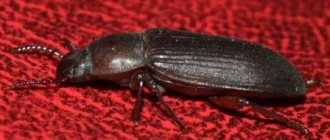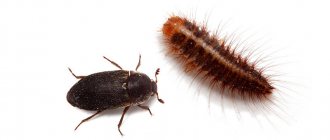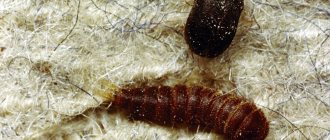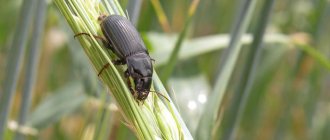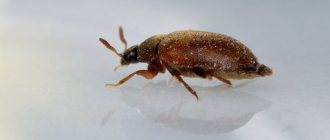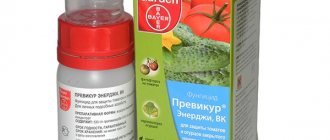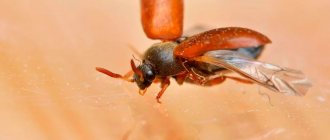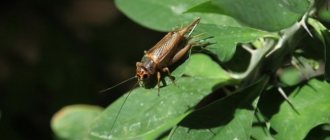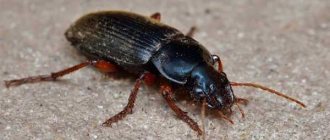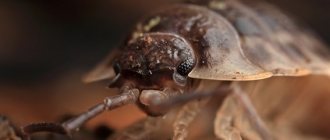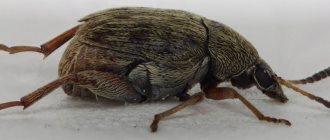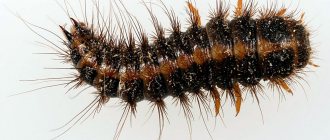Many insects do not mind feasting on food supplies that are located in the kitchen or other storage areas. The mealworm is also found here. Bulk food products are spoiled by both adults and larvae. These insects disguise themselves as furniture or food, so they are not easy to detect, especially if there are still very few of them.
The flour beetle can appear in any housewife, regardless of sanitary conditions, compared to other types of pests. Therefore, any housewife should know how to get rid of these insects and what measures should be taken to prevent the flour beetle from appearing in the apartment, among food products.
Harm to humans
What is the danger of the torment beetle?
Parasites feed on almost everything; they feast on flour, bran, semolina porridge, even some semi-finished products. In the absence of other food, beetles actively eat chocolate, nuts, dried fruits, glue, cardboard, and knitwear. Contaminated products are completely unfit for human consumption. The larvae can be removed mechanically, but beetle eggs are difficult to notice; sifting through a sieve will not help due to their small size. The eggs are covered with mucus, which helps food stick to it. Pests infect the hosts' food supplies with products of their vital activity, skins, and food acquire an unpleasant aroma that is difficult to get rid of.
There are reliable facts that the beetle larvae have gnawed through burlap, even tarpaulin. Therefore, parasites can infect bedding and other items made from natural fabrics. Even domestic animals suffer from beetles, and people become disgusted. Beetles multiply quickly, you need to start fighting them as early as possible, otherwise you will have to destroy a whole horde of parasites.
Important! Eating contaminated food is prohibited; neglecting this rule promises the development of an allergic reaction, serious food poisoning, even intoxication of the body.
Bugs in the apartment - photos and names
Woodworm
- The bug is no more than 3 mm in size and is brown, sometimes black.
- The danger comes from the larvae of this beetle, which can live in wood for many years.
- These pests literally turn the tree into “wood dust.”
Book louse
- A very small bug. Its body length is only 1 mm.
- Color - various shades of brown.
- In an apartment, the pest lives on bookshelves, as it feeds on the glue under the bindings of books.
- It is very dangerous for home libraries, as it can significantly spoil the appearance of books and albums.
Carpet beetle
- A small brown bug. The length of its body is no more than 5 mm.
- He feels good in apartments, as he eats foods available in the kitchen and various cereals.
- In addition, it can cause more serious damage, damaging furniture, carpets, as well as wool, silk and leather products.
- Finally, the bug is dangerous to humans because it bites, and therefore can infect a person with infectious diseases or provoke allergies.
Bark beetle
- The bug is extremely dangerous.
- Body length reaches 1.5 cm.
- It lives under the bark, feeding on wood. Pest larvae feed on tree sap.
- This pest and its larvae can quickly destroy everything in an apartment that is made of wood.
- It is very difficult to get rid of this type of bugs.
Flour beetle
- The bug is brown in color.
- The length of its body is from 5 mm to 2 cm (small and large Khrushchak, respectively).
- A small mealworm lives in a person’s apartment. He lives in the kitchen.
- It multiplies very quickly.
- In a short time it can spoil flour, various cereals, pasta and dried fruits.
- The larvae of this pest are called mealworms.
springtail
- A small white bug. Body length up to 1 cm.
- Lives in flower pots.
- It feeds on the roots and leaves of plants.
- It easily spreads from one plant to another, as a result of which the latter begin to wither and die.
- Springtails love moist soil, so you should avoid over-watering indoor plants in your apartment.
Grinder
- A relatively small bug. Its body length ranges from 1 mm to 1 cm; It even looks cute.
- Color – dark brown, black.
- Sensing danger, the pest immediately pretends to be dead.
- The beetle makes sounds by which you can understand that the pest has entered the apartment and has begun its destructive activities. These sounds are similar to the ticking of a clock.
- The larvae of these insects are very dangerous. They eat up to 99% of the wood.
- The apartment is usually inhabited by furniture, comb-whiskers and bread grinders.
- The furniture grinder literally eats furniture, making holes in the wood with a diameter of up to 3 mm.
- The comb grinder, as the name suggests, has long mustaches. The pest stays deep in the wood until it is completely destroyed.
- But the bread grinder prefers to wood the more delicious food that he finds in a person’s kitchen. These are, naturally, various cereals, pasta, dried fruits, etc.
Silverfish
- The bug is small.
- It has a beautiful silver color.
- It loves warmth and moisture, so in an apartment it can be found in the toilet, in the bathroom, at the kitchen sink.
- It feeds on sugar, starch, as well as any products containing these components.
- The bug is not dangerous for humans, since it does not bite and, therefore, is not a carrier of infections.
Shashel
- The bug is very small. Its body length is only 3 mm.
- Can fly.
- The color is most often black.
- This pest lives in wooden furniture and wooden walls.
- The larvae of this insect make passages inside the tree, from which dust then falls. And if such rot is noticed, it is necessary to urgently take measures to destroy the bugs.
INTRODUCTION
Coleoptera (Coleoptera) constitute one of about 30 orders of the insect class (Insecta). In many respects, the order Coleoptera stands out clearly from other insects and is therefore a favorite object of interest and study among both professional scientists and nature lovers. [45]
Coleoptera are unique animals due to the fact that they can adapt to completely different living conditions, they can be found in all latitudes, in different habitats, their nutrition is based on any organic substances, many species reach high numbers. Therefore, we can say about the representatives of this order that they are omnipresent. For example, they can be found on the sea coast, in the summer high in the mountains at the very edge of the eternal snow. The only place where they have not yet been found is Antarctica, but some species are known to live on the sub-Antarctic islands.
Coleoptera are diverse in shape, color, size, sculpture of outer covers, the presence of various outgrowths, etc., they are a source of inspiration for people who create beauty, these are artists, designers of ornaments and patterns, sculptors, even writers and composers.
Coleoptera can be helpers and pests in such industries as agriculture, forestry, storage of objects and products made of fur, fabrics, leather, wood, and food.
But we must not forget about other species that experience inconvenience due to the fact that humans interfere with their habitats, engaging in economic activities and reducing the numbers of certain species. It gets to the point that some species completely disappear from the Earth.
Regarding ecology, it can be noted that some types of beetles respond very well to the ecological state of the environment, so they can be used as indicators of pollution that humans introduce into the environment.
That is why it is necessary to understand that knowledge about beetles is necessary not only for coleopterologists, but also for plant conservationists, foresters, agronomists, food industry workers, reserve staff, museum specialists, ecologists, and many others.
In this regard, it is necessary to pay attention to the study of Coleoptera in a school biology course, as an extremely necessary element of biological education, because The knowledge gained in biology lessons forms the basis for understanding environmental problems and finding solutions to them.
In a school biology course, the class Insects is usually considered using the example of representatives of this class that are more familiar to any person: the butterfly, the May beetle, the bee, and the ant. But the problem is that each of these insects has many differences. We propose to study insects using the example of mealy beetle, because you can not only see it in a biology lesson, but also grow it yourself and trace its entire life cycle, noting the features of its structure, nutrition, development, habitat, etc.
Before carrying out this work, certain goals and objectives were set.
- Goal: to develop a methodology for studying the class Insects using the example of the large mealworm.
Tasks:
- Conduct a theoretical analysis of the biology of the mealy beetle.
- To identify methodological conditions conducive to the study of the class Insects using the example of the large mealworm in practical activities.
- To study the results of using the applied methodology in the process of teaching children with SLD and prove its effectiveness.
Hazard to human health
Let's find out why insects in cereals are dangerous and how they can affect your health. Small black bugs in the kitchen do not pose a threat in themselves. The problem is a large number of eggs and voracious larvae, which reduce the nutritional value of the affected product. Their waste products may contain antigens to which the body will react by developing an allergy.
The most dangerous pests in this regard are flour and semolina, since their excrement is often indistinguishable from particles of these products and can provoke an allergy attack and exacerbation of asthmatic symptoms.
If there is a mucoid infection, then there is a high probability that mold will also get into the food (remember that mucoeds love high humidity). Cereals and flour with such pests can lead to poisoning or intoxication of the body, especially with prolonged consumption of spoiled groceries.
Why?
There is no 100% insurance against the appearance of bugs in cereals. When making stock purchases of cereals and bulk goods by weight, especially in markets and large chain stores, there is a danger of acquiring enemies for free. This threat is not eliminated by the preference only for factory-packaged food products. There is no point in looking closely at the cereals - the threat is too small and invisible to the naked eye. Contaminated products cannot be recognized by smell either.
Bugs and other insects (their eggs and larvae) successfully parasitize and multiply very quickly in openly stored cereals in elevators or other warehouses. Unscrupulous producers and sellers are guaranteed to condemn the consumer to a difficult, lengthy struggle for household food supplies.
It should be remembered that bugs in cereals themselves do not pose a direct threat to human health, but their waste products can cause allergic reactions and diseases.
Methods for killing insects in products
Methods for getting rid of parasites in food products in the kitchen depend on the type of pests and the products themselves. As for flour, the answer is clear: the flour should be thrown away. The likelihood of toxic and allergenic pest excrement getting into the product is too high.
If parasites have infected the cereal, it should be washed in water. Beetles and their larvae are lighter than water, so they will float to the surface. Legumes should be soaked in salt water for some time. Then the water is drained and the products are dried. Before washing, it is advisable to sift the cereal through a sieve with medium holes in order to get rid of grains of pest excrement.
Pests of cereals and flour in the kitchen cannot tolerate extreme temperatures. Therefore, it is enough to place bags of cereals in the freezer overnight or heat the cereals in the oven at a temperature of 110 degrees Celsius, distributing them on a baking sheet.
Borax-based bait can be used as a chemical pest control product. Semolina, powdered sugar and borax or boric acid are mixed in equal proportions into the dough and rolled into balls, which are laid out in kitchen cabinets. The recipe is especially effective against flour beetle.
Important! Under no circumstances should you use chemicals to control pests. You can be poisoned by toxins! Regardless of the chosen method of combating the pests themselves, it is necessary to treat furniture and utensils where pests lay eggs
Treatment is carried out with a vinegar solution
Regardless of the chosen method of combating the pests themselves, it is necessary to treat the furniture and dishes where the pests lay eggs. The treatment is carried out with a vinegar solution.
Methods for getting rid of black bugs in the kitchen
If you find bugs in the kitchen, take the necessary measures to destroy them:
- Identify and correct the source of the problem. Empty the cabinets and review all supplies of cereals, flour, dried fruits, tablets, tea and coffee. Place spoiled food in a bag and place it in the trash.
- Inspect the kitchen furniture, window sill and household appliances - sometimes uninvited guests are found in such unusual places.
- Wash food storage containers with soda solution.
- Wipe the doors and shelves of cabinets in the kitchen with a cloth soaked in a solution of vinegar (1 tablespoon per 1 liter of water) or detergent.
- Seal or seal any cracks that are discovered during cleaning.
- Pack the remaining intact cereals in an airtight glass container and take them outside the kitchen for 10-14 days. If no insects appear in them during this time, they can be eaten.
Products that could be contaminated with parasites are subject to special treatment. The following methods are used for this purpose:
- exposure to ultraviolet radiation;
- exposure at high temperatures in the oven (10 minutes at a temperature of +100…120 ℃);
- exposure to low temperatures during the day (in the freezer).
Folk ways to fight bugs
To combat bugs in the kitchen, products with a bright aroma are used. Pests are repelled by the smell of bay leaves, lavender, garlic, wormwood, borax, vinegar and nutmeg. To get rid of pests, place any of them on the shelves of the closet and do not forget to change them periodically.
Traps that you can make at home will help you get rid of pests:
- Combine borax and powdered sugar in equal proportions.
- Pour the mixture into the lid and place the trap near the pest habitat.
- Check the bait regularly and refill it if necessary.
Chemicals in pest control
When folk remedies do not help cope with pests, perform chemical treatment of the room. The method is used in exceptional cases with large-scale damage.
Treating cabinets with chlorine-containing products (Domestos, Belizna, etc.) will help you deal with bugs in the kitchen. Wipe all shelves, walls, cabinet doors and leave the room to ventilate for a couple of hours. After a day, repeat the treatment.
Other means to combat bugs in cereals and in the kitchen:
pyrethrum powder. Sprinkle the product where you store food and after a couple of days you will forget about pests. The insecticide is safe for pets and people; "Lovin Fire Protection". An effective poison for flour eaters and bread grinders. When using the product, wear a respirator, as its fumes are dangerous to humans; "Anti-bug." Treat wooden surfaces with a special protective agent - it will not only get rid of pests, but also prevent their appearance in the future
Be careful when working with the product, as it is dangerous if it comes into contact with the skin or mucous membranes; "Rogneda". The drugs of this brand are effective in combating various pests - bugs, ants, flies, fruit flies, cockroaches
According to consumer reviews, proven Dichlorvos will help remove bugs forever. Procedure for using the aerosol:
- Hide all food products and throw away spoiled products.
- Wash cereal containers and all kitchen cabinets.
- Make sure there are no pets or children in the room. Take personal safety measures - wear a respirator or bandage.
- Spray the room with an aerosol and close the kitchen for half an hour. Then turn on the hood and open the window to ventilate the apartment well.
Photos and names of black beetles
You can determine exactly what the black beetle in the house is called by its appearance and size, as well as its location. They can settle both in food and in furniture, carpets or wooden structures and walls.
The most common black beetles, which sometimes settle in an apartment or private house, are beetles or flour beetles. They received their second name because they prefer to eat cereals and other bulk products.
In total, there are 3 types of Khrushchak:
- large beetles - differ in their length (up to 13 mm);
- small – have a size of up to 3.6 mm;
- black - distinguished by black color.
Black bugs in the apartment
In addition to the flour beetle, there are other types of small black bugs in the apartment:
- skin beetles - small black insects up to 4 mm in size that feed on fur and leather products, paper from books, indoor plants and food (flour, nuts, cereals, meat, etc.) - live in closets, old clothes, crevices of furniture; dangerous because they can carry infections and helminths;
- carpet beetles - they settle in beds and carpets, feeding on old peeling human skin, hair and crumbs; they can render things unusable and also cause allergies in some people;
- fleas are small jumping parasites that bite painfully and can carry infection; they often appear in homes where cats and dogs live.
Where can it come from?
The mealworm can't appear out of nowhere. Most often, it gets into apartments along with purchased and already contaminated products, and in the comfortable conditions of warm apartments it begins its active development.
Another way could be attics and dovecotes. During the warm season, the windows are most often slightly open, so getting into the house will not be difficult.
Pests can also come from neighbors, especially if they breed bugs and larvae as bird food.
What types of “domestic” insects are there?
Representatives of about 15 species of arthropods take root in the apartments.
Mukoed Suriname
The cereal beetle loves bulk food and breeds in them. The insect is difficult to detect because its body length is only 3.5 or 4 mm. The Suriname mucoede excretes excrement into the cereal, and the product begins to rot.
After eating porridge made from buckwheat with bugs, a person suffers from an upset stomach; the husk causes allergies. The insect lives up to 3 years, during which time the female lays about 5 hundred eggs 1 mm in size. The flour beetle reproduces well at room temperature in the dark; it usually gets into the house from the store along with a bag of cereal.
Flour beetle
The insect easily crawls into cracks, where it hides eggs, from which larvae emerge. In houses and apartments, the black beetle prefers to live in the pantry or settle in drawers in the kitchen. Khrushchak insects penetrate along with bulk products and love raw cereals and wet flour.
Grinder
Miniature beetles cause enormous harm, destroying plywood and cardboard, damaging wooden furniture and walls, and gutting books. The larvae of some types of borer do not disdain:
- medicines and tobacco;
- plaster and glue;
- bakery products;
- cereals and flour.
On the chest of the insect there is a shield, when struck by it the beetle gnaws its way, making a sound reminiscent of the ticking of either a clock or an explosive device.
food moth
A butterfly less than a centimeter in size often settles in the kitchen, where it breeds offspring, burrowing into nuts, dried fruits, and cereals. For insect reproduction, high humidity and regular ventilation of the room are sufficient. In flour, millet, buckwheat, noodles, food moths leave feces and dead larvae, and it is easy to get poisoned with such products.
Red mukoed
A small beetle with an oblong shape, it is most often found in mills, granaries, and bakeries. The insect's body is covered with villi, its hard wings are colored red. The bug breeds in high humidity and prefers to multiply in raw flour and rotten feed.
Rice weevil
An insect with bright spots on its wings, native to South Asia, quickly spread across all continents, with especially many bugs in regions with hot climates. The rice weevil feeds on cereals and does not refuse buckwheat and millet. The female insect lays eggs inside the grain, for which she gnaws holes. The beetle larvae eat all the substances, after a month they gain weight and become pupae.
Peculiarities
The flour beetle (tenebrio molitor) is a beetle up to 18 mm in size and has an oblong body covered with a black or brownish-brown shell. It belongs to the family of darkling beetles, the representatives of which are distributed everywhere. Adults are able to live even in cool rooms, but larvae require warmth for development. At subzero temperatures, insects die.
The beetle reproduces quite actively: a female is capable of laying up to 1,000 shiny milky eggs during her life. After 10 days, larvae appear from them, which are popularly called mealworms. Flour beetle larvae reach a length of up to 3 cm. They have very developed upper jaws and paws, thanks to which they can quickly move along the surface of bulk products.
There are several types of Khrushchak:
- The small mealworm is a beetle with a flat body up to 5 mm long and red-brown in color. The insect has wings, but is not capable of flight. Thanks to the presence of glands, the pest secretes a specific liquid, with the help of which it scares away enemies. The larvae of the small beetle grow up to 7 mm; they are born from sticky oval eggs of a yellowish color. The full development cycle lasts about two months;
- The large mealworm is a brown-black flying insect of the order Coleoptera with a red belly. Adults can reach up to 18 mm in length. Despite the absence of eyes, the larvae of the large beetle are very mobile thanks to their tenacious legs and claws. Can grow up to 30 mm. Large tormentors prefer to settle in places with high humidity;
- The small black beetle is a black or brown pest whose size reaches up to 5.5 mm. It differs from the small flour beetle in its larger size. It has a white belly and a matte shiny surface on the outside. Its light brown larvae transform into pupa within a year.
Types of pests
The following types of household pests are known today:
Bread grinder
It is found in bakeries, where they forget about basic hygiene and disinfection methods and, perfectly adapting to almost any environment, ends up with the products in homes. The size of the insect is 3 millimeters in length, it flies perfectly, which allows it to quickly move from place to place and, because of this, it is more difficult to eliminate. Usually he eats bread, but he can also enjoy rice, buckwheat, tea, animal food and even an old book.
Mucoed
Prefers flour, cereals and grains. It is very voracious, despite its tiny size - 2 millimeters in length. The flour beetle larva is even smaller, so it is difficult to notice it right away: black dots found in flour are a sign of the presence of mucoed larvae in it. The beetle is very prolific, producing offspring up to 7 times a year in large quantities. Therefore, in just a couple of months, flour can turn into a breeding ground for these insects. The ideal environment for mucoed is high humidity and warmth.
Flour beetle
This is a small insect up to 4 millimeters long, reddish-brown in color. It multiplies rapidly, and settles not only in flour and cereals, but also in furniture and dishes. Breeding a beetle is very difficult, as it is unpretentious to living conditions and is hardy.
food moth
She looks like a simple moth. The length of its body does not exceed 1 centimeter. It is characterized by high fertility (over five hundred eggs in two weeks, from which caterpillars hatch). The moth devours cereal reserves at high speed. Her ability to hide, fly and disguise herself as dark objects makes her virtually invulnerable.
Weevils
They can appear in literally all products: cereals, flour, bread, dried fruits, fruits and vegetables. They look like small bugs, about 5 millimeters in size with a long proboscis. Weevils can fly, changing their location depending on changes in environmental conditions, and also easily climb walls. The pest produces offspring up to 6 times a year. They settle everywhere: remote corners of the kitchen cabinet, containers of cereals, bed linen, baseboards, cracks.
Tenebrio molitor L.
|
Two darkling beetles - large and small flour beetles - are perhaps our most unpleasant domestic parasites. Their appearance is almost inevitable where food supplies are stored in large quantities for a long time,
Spreading
The large mealworm is a typical synanthropic species, therefore it is distributed almost everywhere where people live. It can be found on all continents.
External signs
The beetle has an elongated body 12–16 mm long. The color of the elytra is pitch-black or brown with a greasy sheen. The elytra have clear grooves; the dots in them are not always black. Below the body is light, yellow or red-brown. The legs are also red-brown. The young larva is white, the adult is yellow, reaching a length of 30 mm.
Lifestyle
In nature, beetles appear in late spring. The female lays bean-shaped eggs in quantities of up to 600 pieces in flour or glues them in groups or individually to various products, containers, and walls of premises. The larvae, which are known to many as “mealworms,” damage the grain and first of all destroy its most nutritious part – the embryo. They live for a very long time. If there is little food or if there is too much crowding, their development may slow down. At the same time, they will molt significantly more times than usual (up to 15). As a result, the larval stage can last almost 2 years.
The larvae have a well-developed chitinous cover, due to which they acquire significant hardness and resistance to external pressure
This is very important for them, because sometimes they are forced to develop in large masses of food material, experiencing significant weight loads
Large mealworm larvae
Pupation occurs behind planks, in cracks, in flour dust, and in the seams of bags. It is often at the pupal stage that beetles spread over considerable distances, often crossing seas and oceans. After two to three weeks, beetles emerge from the pupae, whose mass appearance is often indicated by a specific unpleasant odor.
Role in nature
One circumstance contributes to the widespread distribution of beetles in city apartments. Typically, the trade turnover of products occurs quickly: manufacturer–wholesaler–store–consumer. But in extreme economic conditions, it may be necessary to turn to strategic food reserves. And they, unfortunately, are not always kept in perfect condition. Often, it is in huge warehouses and elevators that various harmful insects accumulate during long-term storage of products. From here they flow to consumers in “difficult years”. Many countries have faced this problem at different periods of modern history.
An excellent use has been found for the large beetle, which is why it is often specially bred. The goal is to obtain larvae. These shiny, smooth, yellow “mealworms” are used by pet hobbyists as food for insectivorous birds, reptiles and many other captive creatures. This is an excellent bait for fishermen.
The ease of breeding mealworms is facilitated by their omnivorous nature. They feed on more than just plant foods, cereals and dried bread crusts. If you throw the corpse of a small animal or bird into a container with them, then in a short time they will eat its meat so cleanly that a beautifully finished skeleton will remain, suitable for displaying in a museum.
Now, having familiarized yourself with the biology of the large beetle, you can easily guess the riddle that Vladimir Dal gives in his “Explanatory Dictionary”: “There is a mansion, in the mansion there is a box, in the box there is a bug, in the box there is a bug.”
Fighting methods
What to do if bugs still appear in flour and cereals?
Disposal
The main method of combating the bug is the disposal of affected supplies. Of course, it’s a great pity for spoiled flour or cereal, but if there are insects in it, it means that a couple more days will pass and they will crawl throughout the house. Therefore, it is urgently necessary to tie the bag tightly and put it in another bag and take it to the trash.
After disposal, it is necessary to wash kitchen shelves and cereal storage containers (if any) with bleach, soda or vinegar. After treatment, be sure to rinse the surfaces with water.
Heat treatment
All types of insects die at temperatures above +50 degrees. This can be either boiling water or steam treatment. This method is good for eliminating bug nests in baseboards and crevices that cannot be reached with chemicals and sanitation.
To remove bugs directly from cereals, you can fry them in the oven at a temperature of about 50-70 degrees for 20 minutes. Or put it in the freezer for several hours. Insects die at temperatures below 15 degrees.
When the larvae and adults are destroyed, it is necessary to thoroughly rinse the grains (beans, beans, nuts) with water and wait for the pests to surface. Then, drain the water and rinse the product again so that there are no larvae left in it. After heat treatment, it is better to sift flour and small grains through a sieve 2-3 times.
Chemicals
On open kitchen surfaces, it is better to use special chemicals, which are sold in abundance in hardware stores. Just don’t buy simple remedies for cockroaches and ants to fight the bug. In this case, specialized products are needed, for example, “Antizhuk” or “Karbofos”.
“Anti-bug” helps in the fight against any bug, be it cereal or wood, that damages windows and furniture. The drug is quite effective, but be sure to read the instructions before use, as it is toxic.
To remove insects, you can use “Rogneda” - a powerful antiseptic that can destroy weevils, mucoeds, as well as ants and cockroaches.
Another effective remedy is Lovin Fire Protection. The drug kills the beetle in the shortest possible time, but it must be scattered in places inaccessible to animals, as it is a powerful poison.
Folk recipes
Recipe 2.
Mix boric acid, flour and powdered sugar in equal proportions, which serves as an excellent bait. Scatter the mixture in the habitats of the bugs.
Recipe 3.
Insects are afraid of the smell of bay leaves, garlic, pepper and sulfur. It is enough to put a sprig of bay leaves in the kitchen cabinet or lay out simple matches, and reliable protection against pests will be created.
Simple precautions will help you avoid such an unpleasant problem as kitchen pests
- To prevent bugs from infesting flour and cereals, they must be stored at medium humidity in a well-ventilated area;
- You need to make sure that there are no raw or undried foods (dried fruits, vegetables, wet cereals) in the kitchen cabinets. If there are any, then the mucoed will definitely settle in them;
- It is mandatory to regularly inspect products and shelves. Make sure that cereals do not sit for a long time; long-term storage is the main cause of insects.
- Keep cloves, bay leaves and matches in your kitchen cupboard to repel pests.
- Store cereals and grains in plastic or glass containers with an airtight lid.
- If you notice the first signs of spoilage of food, immediately throw it away or rinse or sift through a sieve.
- Carry out general cleaning at least once a month using disinfectants.
The appearance of insects in cereals and flour is a nuisance that many women face. Beetle larvae are very indiscriminate in their food supply and can damage food and even non-food supplies. You should get rid of pests immediately, as they can spoil a large supply of provisions. Their waste products are toxic.
How to get rid of an insect?
First of all, you need to store food correctly, this reduces the likelihood that it will be damaged by pests, and not just weevils.
Methods for controlling beetles in products
It is necessary to review supplies more often in order to identify bugs in time, keep the table and pantry clean, and wipe the shelves with soapy water and vinegar solution. If pests are found, and while there are still few of them, you can sift the cereals and grain; if this is not enough, you will have to fight with insecticides.
Food storage rules
The room where the food is stored should not be humid or too warm. They should be stored away from light in a cool place.
Fighting weevils on indoor plants
Flowers on windowsills can also suffer from the pest. Bugs gnaw through buds and leaf buds, causing them to wither and not bloom. All affected shoots should be cut off and thrown away, the rest should be treated with insecticides Inta-Vir, Fufanon or similar, or the entire flower should be sprayed with mustard infusion (30 g of powder per 1 liter).
Who?
In total, there may be more than 50 species and subspecies of dangerous bugs in the kitchen. Let's describe the most likely guests
Small mealworm
Coleopteran beetle with a shiny red-brown carapace (3–5 mm). It develops from a sticky white oval egg (0.7 mm) into a yellowish larva (3–7 mm), then into a pupa (3 mm). The entire development cycle takes place in 40 days. Maximum lifespan 3 years. During this time, the female lays clutches up to 4 times a year and is capable of reproducing up to 1000 individuals.
First of all, he prefers flour, cereals, and bran. Less commonly, affected cereals, nuts or dried fruits. Doesn't eat legumes, rice, oats, barley. Eggs, larvae, pupae and bugs die at temperatures of 6°C and below.
Under natural conditions, the bug lives under the bark of trees. Habitat from Mongolia to Slovakia.
Other bugs from this family are also found in home kitchens.
The Greater Mealworm or Mealworm is a dull brown-black beetle (15 mm). The larva of a large beetle (30 mm) is very mobile. The beetle itself flies well, which is an additional way of spreading infection. Loves high humidity.
The club beetle is a close “relative” of the small flour beetle. It differs from it in the dull red color of the shell and a much greater love for warmth.
Black beetle or Destroyer is a black heat-loving bug (5 mm). It justifies its second name by its addiction not only to flour, but also to legumes, allspice, and food concentrates. He loves dry glue and starch, so he lives in glued suitcases and starched linen. Damages products made of nylon and knitwear. Lays eggs in crevices of walls, floors and furniture.
Red mukoed
A small, well-flying, gnawing bug (2 mm), yellow-rusty in color with a hairy carapace. Lives up to 6 months and can fall into three-month suspended animation. They are easily recognized by their cream-colored larvae (4 mm) with long hairs and one reddish tip of the abdomen. In a year, a female can give 5 generations. Preference is given to affected flour, cereals, and seeds. He loves corn very much. Habitats: Eurasia and Australia.
Bread Grinder or Pharmacy Beetle
Cylindrical (2–4 mm), brownish red-brown, with a soft hairy shell.
White-dirty arched larva (6 mm) with a yellowish-brown head. She is indiscriminate and eats literally everything, including even poisons and toxic drugs. What it cannot eat infects it with waste products that are especially dangerous to the health of humans and domestic animals.
How to get rid of a bug in cereals? Particular attention should be paid to the appearance of this nuisance in the middle of summer - check the bags and packaging for cluster-shaped clutches of dirty milky eggs, the presence of round holes and lumps in the products
This flying bug is nocturnal and knows how to pretend to be dead in case of imminent danger.
Barn mites
A very numerous and ubiquitous species of parasites (0.2–0.4 mm). The most significant biological pests in terms of damage to humanity. They prefer wheat, rice flour and grains. Found in bone meat and fish meal. They reveal themselves by changing the original color of the product and its slight lumpiness.
Dangerous for humans as a risk group for developing asthma, catarrhal and gastrointestinal allergies. Tick waste products are also toxic to pets.
Tribolium confusum Duv.
|
You can encounter the small flour beetle much more often than the large one. Of course, we do not mean possible encounters with them in pet stores or at bird markets. Beetles and small mealworm larvae can accumulate in products during long-term open storage. If at least one beetle or one larva is found in a bag of flour or pasta, we can assume that it is no longer your food supply, but his. In this case, it is almost impossible to get rid of the pest. Even sifting does not help, since the beetle eggs are so small that they pass through the tiny holes of the sieve. And in appearance they are practically indistinguishable from grocery bags. That’s why this beetle is sometimes also called the deceiver Khrushchak.
Spreading
This beetle is synanthropic and cosmopolitan.
External signs
The beetles themselves are small, 3–4 mm in size, with an elongated, bare, slightly shiny red-brown body and parallel elytra.
Lifestyle
Their lifestyle resembles that of their “big brother”. Distributed everywhere in the same places as the large beetle, although it is less common in granaries and more often in houses. Beetles and larvae damage rye, wheat and rice flour, bran, semolina, and rolled oats. They eat buckwheat, rice, and dry fruits less often. Due to their small size, they penetrate into loosely closed boxes or display cases with zoological exhibits and often damage them.
Small mealworm larva
The female's fertility is up to five thousand eggs. They put them in cracks, flour dust, on sacks of flour, bran and grain.
Role in nature
Scientists have discovered an interesting pattern: the fecundity of the small beetle at 27°C is lower than at 34°C, but in the first case, larvae hatch from all eggs, and in the second, from only 75%. Typically, larvae hatch from laid eggs on the 6th–7th day. Products colonized by them acquire an unpleasant odor, flour forms lumps and becomes unsuitable for baking bread. The entire development from the egg to the emergence of the beetles in a heated room takes about a month. Several generations develop over the course of a year.
Control measures
The most common and effective method of combating both beetles is gas fumigation of long-term stored products, warehouses, and grain tank holds.
Such processing should be carried out with all necessary precautions.
However, you can get rid of the small mealworm in a simpler way - by cooling the substrate where it was found. Insects die when exposed to temperatures below 7°C for several weeks.
Sanepidemstation.com in the fight against Khrushchak
Pests that have the ability to cause significant inconvenience to humans - flour beetles - can easily be destroyed as soon as possible if you take care to seek the help of professionals. The specialists of Sanepidemstation.com are ready to offer their services for the quick and effective treatment of warehouse, commercial, and residential premises from pests using modern equipment. Spraying drugs using fog generators involves the use of highly efficient technologies.
The visit of specialists allows you to achieve maximum effect in pest control and gives pronounced results within the first few days after the treatment. The cost of treating apartments and houses with insecticidal agents against flour beetles depends on the area of the objects. Chemicals are sprayed under high pressure, creating fine dust that penetrates into the most inaccessible corners of the space.
We recommend:
- Bugs in the kitchen
- Destruction of moths in Moscow and the region
- Skin beetle - how to get rid of it?
- Destruction of bark beetles with a guarantee
- Linen lice: extermination of insects from SES
- Silverfish in the bathroom and apartment: how to get rid of it
